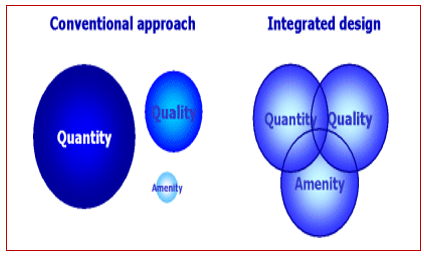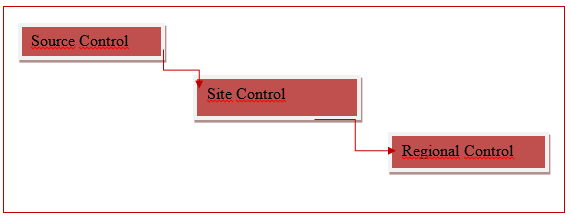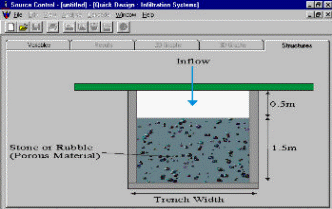Aim
The aim of this project is to conduct a detailed discussion on Sustainable Urban Drainage Systems (SUDS) and available sustainable drainage techniques that can be made integral to the design and construction of a large capacity shopping complex and car park in the area of Salford scheduled for completion by 2012.
Definition of sustainable system (SUDS)
Sustainable Drainage Systems (SUDS) are cost effective and superior drainage techniques that are characteristically defined by social and environmental factors in sustainably dealing with surface water runoffs not inherent in traditional drainage systems. It thus follows that “Sustainable drainage systems (SUDS) are a natural approach to managing drainage in and around properties and other developments” (Business Link, 2011). “SUDS work by slowing and holding back the water that runs off from a site, allowing natural processes to break down pollutants” (Business Link, 2011). That in effect provides a means of protecting the environment from the destructive effects of runoff wastes (European Water Framework Directive. 2000).
It is important to note that runoff water from construction sites, car parks, and other structures can be treated using SUDS. The cleaning effect of runoff water comes with a range of benefits such as minimizing the potential effect of flooding at construction sites, protecting and ensuring ground water is of desirable quality, and mitigating and minimizing on the destructive effect on the environment. That leads to the efficient utilization of rain water eventually saving on portable water. The table below provides a summary of the benefits typical of SUDS.
It is important to provide a detailed view of the SUDS triangle to be better informed about objectives that define the system. The triangle provides an overview of three variables that synergistically aggregate to achieve system objectives. That is further reinforced by the Scottish Environment Protection Agency (n.d) that asserts that the three functions should be integrated to provide “adequate and well designed systems that offer water quality treatment through natural process inherent in the system, encourage infiltration where appropriate and attenuate peak flows in addition to providing habitat and function for those using the area, including the local community and wildlife” (Scottish Environment Protection Agency, n.d).

SUDS Components
In order to be clearly informed about SUDS, it is important to examine the constituent components that make up the system. These include, but not limited to, filter trains and permeable surface as discussed below (Briefing for UK Roads Board, n.d).
Filter trains and permeable surfaces
Filter trains and permeable surfaces are typically constructed using impervious materials which allow surface water to sip through the voids on the surface. However, the sub-made underlying material provides significant storage and water transportation on the surface. That calls for the use of concrete blocks, permeable blocks, graveled areas, and permeable pavements.
Filter strips
These are vegetated surfaces that are defined by filter strips typically described as “receive and slow down surface water run-off and allow particulate removal and water infiltration” (Briefing for UK Roads Board, n.d). Other SUDS components are detailed below.
Swales
Swales are described as “vegetated shallow channels that slow down and receive surface water runoff and allow particulate removal and water infiltration” (Briefing for UK Roads Board, n.d).
Filter and infiltration trenches
These are also referred to as French drains. Water is allowed to sip through and is transported by perforated pipes and trenches that are lined with crushed rocks. A permeable material causes a filtering effect and “act as a filter and removes sediment from the water. “A permeable geo-textile membrane may be used to line the trench to aid sediment filtering” (Briefing for UK Roads Board, n.d).
Soakaways
These are geo-textile membranes filled with crushed stones.
Underground Storage Systems (Storm cells)
These reinforce the strength of walls using modularized plastic cages that enhance the construction speed of SUDS systems. It allows for a controlled flow of water as an additional benefit.
Basins and ponds
These are typically surface excavation collection points for runoff water. SUDS are environmentally friendly approaches for preserving the environment.
Design criteria for SUDS components
Sustainable urban development systems have in practice been identified to come with superior solutions in the development of urban drainage systems and are a far cry from conventional planning methods that have been in use. Different designs focus n different elements. In this approach, flooding is the element of focus in the design. Therefore, designing for flooding reinforces the effect of “balancing the impact of urban drainage on flood control, quality management and amenity” (Erhardt, n.d). Typically, the design criteria must be established based on predetermined steps. These include identifying an appropriate design approach specific to a specific site.
However, using SUDS does not absolutely guarantee that flooding cannot occur. In addition to that several other elements considered at individual levels must be critically factored into the design. That is because of the significance of the factors in determining the gradual effectiveness of the design. These elements are discussed below (Sustainable Drainage Systems, n.d).
Designing for climate change
The characteristic behavior and functionality of SUDS is dependent on climate variations and associated effects. Typically, higher temperatures appreciate the rate of evaporation of water while drier weather conditions lead to minimal surface running water. However, SUDS performance has been noted to be very poor in rainy environments with a lot of running surface wastes. In essence, therefore, both of the above issues are critical influencing components in the design of development project at Salford, Manchester in the UK. Independent research has projected drastic changes in the climate in the next 70 years (National SUDS Working Group, 2004). These include the statistical frequency with which rain comes, emissions and gases, and other environmental warming effects.
Designing for flood routing
A cost benefit analysis should be conducted in the construction of typical SUDS to balance between cost, the potential for flooding, and the location of the system proposed for construction. To achieve a desirable level of system efficiency, it is necessary to consider the issues discussed below as being critical influencing variables in the design (Briefing for UK Roads Board, n.d)
Designing for Amenity
Efficiently designed SUDS components that meet established standards are bound to provide aesthetical benefits besides ecological and wildlife benefits which come along with the additional benefit of pollutant-tolerant species. In addition to that, the design factors should allow for higher pollution levels when designing SUDS particularly by planting specifies that resist pollution. However, it is important to consider the quality of water in the design.
Designing for water quality improvement
Importantly, a sustained improvement of the quality of water should be an influencing factor in the design of SUDS. Typically, the quality of water can be achieved sustainably by integrating sedimentation as a mechanism to remove pollutants inherent in the flood water. The use of filtration enables the removal of solids from water, biodegradation leads to the disintegration of microbial organisms into finer substances, and uptake by plants involves a number of chemical processes that supports cleaning of water in the system (Management Bill: Briefing for UK Roads Board, 2009).
SUDS Selection
The selection criteria for SUDS are based on established design procedures that rely on the quantity and quality of water, environmental enhancements embedded in the hydraulic and hydrology principles that influence the design process of SUDS. The final SUDS option is an aggregation of appropriate planning, available water resources, demands for the desired quality of water, and the topology of land requirements. It is important for designers to identify and incorporate appropriate tools in the selection process (Briefing for UK Roads Board, n.d). These tools, referred to as selection tools are variably influenced by the management strategy of the surface water train tailored to allow designers make their choices based on the following principles:
- The design criteria met by use of different drainage techniques in series.
- Drainage techniques to be preferred in order of hierarchy, the top getting highest priority.
- External and internal factors to be considered in seeking for appropriate solutions among a variety of options.
- Leaning and integrating original design factors into new SUDS to inspire new developments.

All factors have to be integrated and considered in the design process to ensure not a single factor overrides the other. On the other hand, designers have the flexibility to manipulate other issues to meet the design requirement.
The above diagram explains the management train that allows designers to categorize areas targeted for drainage into sub-catchment areas to ensure the above mentioned principles such as hydrology is fully utilized in the design process. It is important as a critical factor to consider the four steps of the management train as discussed below (Briefing for UK Roads Board, n.d)
Good housekeeping
Typical of this step is a reduction of environmental pollutants and minimizing the potential probability of flooding (Briefing for UK Roads Board, n.d)
Source Control
These are measures meant to reduce the effects of rain water at the source.
Site controls
Measures and tools to cab run-off water upstream.
Regional control
This exploits larger features for collection purposes and incorporates the issue of evaporations and is the terminal point of the whole process train.
SUDS for the proposed project
The selection process is based on the most sustainable to the least sustainable in the hierarchy as mentioned elsewhere.
It can be observed that living roofs are at the topmost of the hierarchy with variables such as basins and ponds and are closely followed by constructions of balance the retention ponds. In the hierarchy that is followed by filter strips and swells, then, infiltration devices, and then filters drains and permeable surfaces while tanked systems at the bottom of the hierarchy (Sustainable Drainage Systems, n.d).
Source Control
The efficacy of this option revolves around natural drainage patterns and individual responsibilities leading to the prevention of anticipated problems. However, infiltration trenches are modern approaches that have been identified to be comparatively very efficient as illustrated in the fig. 3 below.

The above method is cyclic allowing water to be restored back from the source and is a combination of various techniques.
Minimizing Water Treatment through SUDS
The above stated objective can be achieved by reducing the flow of water on the surface, thereby reducing the aggregate effect of runoff water. In addition to that, the effects of flood water are minimized and enhanced quality of running water for both man and wildlife is achieved. By integrating the SUDS mechanisms into the system for trapping water, the system is overly cost effective (National SUDS Working Group, 2004).
Conclusion
SUDS is a more efficient and cost effective alternative to traditional drainage control methods that integrates traditional hydrological principles and other drainage methods along with new drainage methods to achieve the drainage objective in urban areas. It factors environmental issues as an important trend in the modern age making it quite efficient and desirable. SUDS handle the drainage problem that has been experienced in urban areas to mitigate upon the adverse effects that come with flooding efficiently.
References
Briefing for UK Roads Board, n.d. Sustainable Urban Drainage Systems (SUDS) and the Draft Flood and Water Management Bill. Web.
Business Link, n.d. Using sustainable drainage systems to prevent pollution and flooding. Web.
Erhardt, Arthur. n.d. Sustainable Urban Drainage Systems. Web.
European Water Framework Directive. 2000. Directive 2000/60/ec of the European Parliament and of the council. Web.
Management Bill: Briefing for UK Roads Board. 2009. Web.
National SUDS Working Group, 2004. Interim code of practice for sustainable Drainage systems. Office of the Deputy Prime Minister. Web.
Scottish Environment Protection Agency, n.d. SUDS explained. Improving water Environments. Web.
Sustainable Drainage Systems, n.d. The Construction Center. Web.